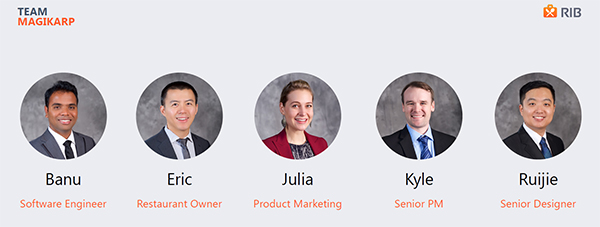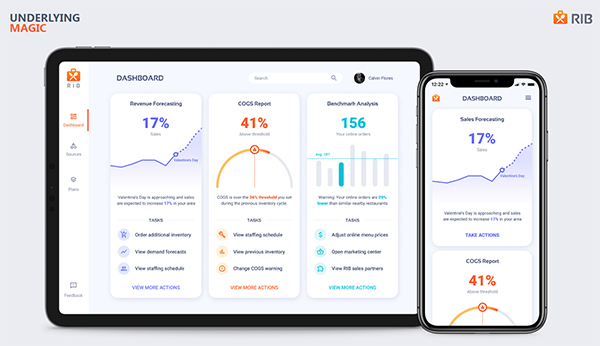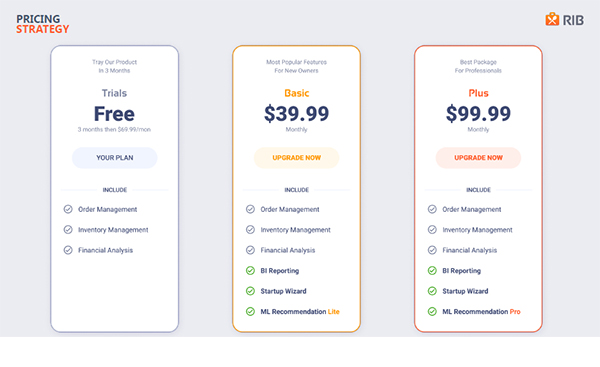TMMBA Student Teams Compete in EXPO Business Plan Competition

Recently, Technology Management MBA student teams competed in the TMMBA EXPO Competition, a business plan competition built into the course, Entrepreneurial Influence and the Pitch. This competition occurs in the second year of the TMMBA program to provide students the opportunity to put into practice all the business concepts they have learned to date. One student team, Team Magikarp, emerged the victor with their business idea, “Restaurant-In-A-Box.”
Recently, during a ZOOM interview, all five team members talked about how they came up with their business plan idea, what they learned about teamwork during the process, and why they think their plan won the competition.

The Idea
Kyle Abraham’s father-in-law, who has a small medical practice, had mentioned how difficult it is to manage a medical practice to Kyle, Senior Program Manager at the Bill & Melinda Gates Foundation. That led the team to consider developing software that integrated all the functions needed to run a medical practice – a “Business in a Box.”
After considering the immense number of regulatory complications in the field of medicine, they decided to pivot their concept to a different type of business. That’s when they chose the restaurant industry. Teammate, Eric Wan, Microsoft Senior Product Manager and owner of Dickey’s Barbecue Pit in Bellevue, explained the need. “Even though my restaurant is a franchise, no one provides you with the recipe on how to run a (restaurant) business or how to use industry data to help optimize and run that business.” With enormous market potential and Eric’s industry expertise, the team sat down to design a comprehensive solution to this pervasive problem.
Teammate Julia Gall, Product Marketing Associate at Verathon, Inc., says, “No one person came up with our idea. It was a snowball effect; we just kept adding and tweaking and getting feedback. It was a very iterative approach. We all were inspired and annoyed each other to push further and further.”
The result was “Restaurant-In-A-Box” (RIB).

Figure 1: Dashboard Prototype. Visualization by Senior Designer, Ruijie Cao
The Pitch
Their business pitch points out that nearly 60% of restaurants fail in the first year and about 80% close their doors within five years. With RIB, restaurants can use this AI solution to aggregate data from systems the restaurants already have and turn it into actionable decision making on such things as inventory, staff levels and schedules.
60% of restaurants fail in their first year – often due to poor decision making.
- What are my staffing needs?
- Am I spending enough on marketing?
- How many customers to expect?
Source: Business Insider/Ohio State University
It allows participants to look at benchmarks from across every restaurant on the platform to allow them to adjust menu prices, look at seasonal and holiday changes in restaurant attendance, and to make other decisions to increase their restaurant’s success. The software integrates information from systems that participating restaurants already have, such as PayPal, Square and Toast.
RIB would offer three plans, Free (Trial), Basic, and Plus, each with progressively more features. The team projected that the first three years would be spent developing the product to build partnerships and they expected to make a profit in 2024. In the context of COVID-19, Kyle says, “Restaurant-In-A-Box now may be more relevant than ever. It can play an important role in advising restaurant owners how to appropriately scale up with restricted capacity. Owners often rely on their many years of experience and market observation to drive purchasing and staffing decisions. With the market artificially constrained by current state mandates, the app is critical to establishing a new normal.”
 Figure 2: Proposed RIB Pricing Strategy. Visualization by Senior Designer, Ruijie Cao
Figure 2: Proposed RIB Pricing Strategy. Visualization by Senior Designer, Ruijie Cao
Teamwork
When asked why he thinks their plan won, Banuchandar Kumarasamy (Banu), a software engineer and currently Program Manager at Amazon, said that his team picked the right product that resonated with the audience they pitched to, who were most interested in software products. Says Kyle, “We focused on a product that had a market that was pretty big and addressable; we found a pain point with a market that we could potentially capture and that separated us from some of the other products.”
Ruijie Cao, Senior Designer at Microsoft, who created all the mock-ups and designed the final collateral for the presentation deck [highlighted in this post]. He noted the diversity of skills within the team to their success, the many skills that the members brought to the project. He credits Eric, Kyle and Banu with top notch management of the project. The team also greatly appreciated the skills and work of Julia, who did extensive research on the competitive landscape and cleverly researched all the venture capitalists prior to team pitches.
All agreed that the team benefitted from being resilient enough to iterate and move forward despite conflict. Each expressed pride in their ability to navigate the challenges of group decision making and the time constraints of balancing class hours with their jobs, while developing the business plan.
TMMBA Curriculum
When asked how their TMMBA courses aided them in creating and developing RIB, all the team members spoke highly of the suite of courses they took this quarter – Entrepreneurship, Entrepreneurial Finance, and Entrepreneurial Influence and the Pitch – culminating in the TMMBA EXPO Competition.
Throughout the Influence in the Pitch course, all student teams had multiple opportunities to present their business plan to reporters, venture capitalists, angel investors and successful entrepreneurs recruited by course instructor, Rebecca Lovell, one of this area’s most respected venture capitalists and Executive Director of Create 33.
“By the time we got to EXPO,” Kyle says, “the course leading up to that night had well prepared us to answer all the questions we were asked.” Real-time feedback from these industry leaders, they all say, allowed them to iteratively improve the plan and present a responsive and tested business plan that won over the investor judges.
1 Response
Leave a Reply
You must be logged in to post a comment.

Thanks for the information